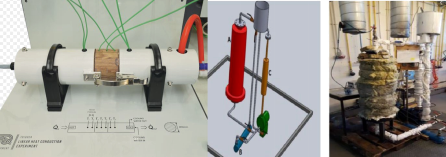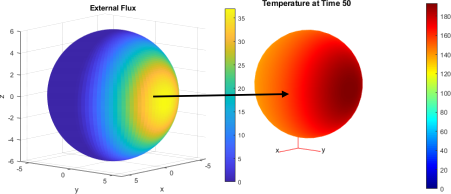ME450 – Heat Transfer
Hello, dear friend, you can consult us at any time if you have any questions, add WeChat: daixieit
ME450 – Heat Transfer
Application of HT Project (AP)
This project is directed to applying the methods, tools and knowledge that you have learned this semester towards a heat transfer project.
There are FIVE open tracks to this project, you must complete this project individually or in pairs. These projects can be focused on applications/projects/research in other classes or academic activities (e.g. thermal fluids or capstone or club projects).
1. Project Tracks
There are five open tracks to this project shown below:
1. TRACK 1 Solidworks thermal simulation - using the simulation add-in package in solidworks, conduct a thermal or heat transfer analysis on a system or part. There are numerous web resources and solidworks has several tutorials related to radiation shield of a liquid metal jet, coffee heater with thermostat, thermal resistance of thin epoxy layers, and thermal analysis.

2. TRACK 2 Senior Capstone Project – Apply your knowledge of heat transfer to your senior capstone project/495 (only if applicable).

3. TRACK 3 Solar Cooker- design a solar powered cooker to cook food using only the power of the sun.

4. TRACK 4 Thermal Fluid Final Project Design Experiment – at the end of you thermal fluids class you will design, build, and test an original experiment. You may use this project, as long it demonstrates topic(s) from this heat transfer course.

5. TRACK 5 Matlab transient heat flow – there are several tools within Matlab and simulink to model unsteady or nonlinear heat transfer problems. For this track, you will be required to model the simple geometry computer project as transient heat flow within Matlab.

2. Design Teams
You may complete this project individually or in pairs. If done in a pair, each member must turn in the same report to Canvas.
3. Schedule Deliverables
This project description will be given during the last two weeks of the semester.
(40% of grade) Project Demonstration (see canvas for due dates)
I. Create a short video (<5-10mins) that demonstrates your project. Please upload your final video to YouTube and submit a link to canvas assignment upload.
In your video describe the following:
a. Give a short introduction to your project and what it is about.
b. Describe your device/process/model.
c. Describe your inputs to your system and what measurements will be taken (if applicable)
d. Demonstrate your project (i.e. run your device, cook your food, simulate, show operations etc.)
e. Describe the outcome of the demonstration and lessons learned (did it work, what went well and did not, is the output what is expected and how you could fix it in the future, etc.)
(60% of grade) Final Report (see canas for due dates)
A succinct final report including the following sections:
I. Final report should have the following
a. Cover page with class, team, and project title information
b. Describe who is in your group (if in a team) and what roles each of you had.
c. Describe your track and problem/system you are solving, including the project constraints.
d. Comprehensive description of your final design including a final picture of the end product and BOM. Add any associated costs or CAD (if applicable).
e. Methods
i. Describe your methods/process/model
ii. Describe any innovative parts of your design/methods (if applicable)
iii. Describe your inputs/initial conditions into your process/model
iv. Describe your testing process and conditions (if applicable)
v. Describe your device output during operation (if applicable, ie. What was operating temp. of solar cooker) vi. Describe your results and output of the system/model.
vii. Interpret your results and describe the implications to both this class and real world applications
f. Validation Process
i. describe and show how you will validate your output/results (i.e. comparison to equations, steady state analysis, or predictions)
ii. Did the results turn out as expected? What went well and what went wrong/failed and why?
g. Suggest at least two future modifications if this was project was redone
h. Conclusions and references in IEEE format
i. Appendices - please provide supporting details, photos, and equations when applicable.
j. This includes Matlab code if applicable.
4. Additional constraints and comments
. There is no restriction on cost of the project although, you may be restricted by other classes (capstone/thermal fluids). All costs should be agreed upon and shared among the group. I would try to minimize costs and use free/ recycled materials.
. Reports should be comprehensive (i.e. I should not be looking /asking for major details of your project) and at a senior level of professionalism.
. Solar cooker project should plan to make equivalent food potions equal to the energy required to heating one cup of water to boiling. Supplemental videos will be shown on bblearn for this process.
. Device can be any size but make it reasonable. Do not make your device into anything that could potentially injure team members, bystander, or damage property.
. Demonstrations can be conducted in any location (does not have to be at NAU or flagstaff).
. There are many different types of solar cookers, but April in Flagstaff can be cold and windy. I would suggest using a solar concentrator design.
. Any restrictions or constraints from other classes (e.g. thermal fluids or capstone) should be applied and documented.
. Solar cooker demonstrations should show team eating food in the end (if it is safely cooked to proper temperature), what day, time, environmental conditions and location in the video.
. Solar cooker must demonstration cooking abilities within 1hr 15min time period (i.e. normal class time). Preheating device or energy storage is allowed prior to demonstration.
. Solar cooker may get very hot and so make sure you use sufficient building material, safety gear and it does not contaminate the food
(believe me I have been forced to eat some by teams)!
. Bonus points awarded to teams (choose one to two options, you cannot earn all the listed points):
o Exceptional and comprehensive job on report and/or final product (+10pts)
o Innovative method or design (+10pts)
o Additional analysis conducted beyond minimum requirements (+10pts)
o Demonstrate prior testing and modifications leading upto final design (+10pts)
o Exceptional Demonstration Video and/or additional food cooked (+10pts)
o Solar cookers that can be built for under $10 (+10pts)
. Penalties
o -25% of grade for unfeasible/un-realistic/poorly attempted design/system OR many errors in calculations
o -100% of grade for fabricated results or faked output. Its ok if it did not work as expected, document the process, comment on why it failed, and how you would fix it if you had more time, but don’t cheat the process.
2023-12-04
Application of HT Project (AP)